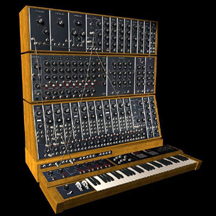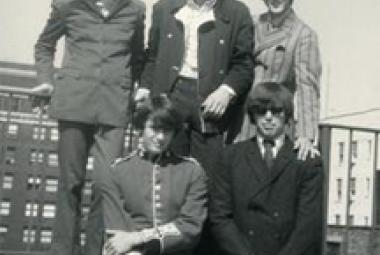Moog synthesizer may refer to any number of analog synthesizers designed by Dr. Robert Moog or manufactured by Moog Music, and is commonly used as a generic term for older-generation analog music synthesizers. The Moog company pioneered the commercial manufacture of modular voltage-controlled analog synthesizer systems in the mid 1960’s. The Moog synthesizer gained wider attention in the music industry after it was demonstrated at the Monterey International Pop Festival in 1967. Later Moog modular systems featured various improvements, such as a scaled-down, simplified, self-contained musical instrument designed for use in live performance. (More from Wikipedia)
Even considering that he is talking about his wife, Alain Johannes can hardly praise Natasha Shneider highly enough for her musical genius. In an interview that features technical talk which is a little beyond me (posted on ultimate-guitar.com), Alain Johannes was asked about Shneider’s essentially playing bass guitar on the keyboard with her left hand while playing regular keyboards with her right: “[P]eople would be watching us and she’d have the keyboard and I’d usually do a MIDI map of the two-and-a-half octaves and later on it became an Ovation Bass Station or the Wurlitzer. So that would feed into a bass amp and it was onstage and it was a huge sound with that Moog Bass in her left hand. She was so independent, she could sit in the pocket with Jack [Irons] and have a different pocket with the right hand, which was basically a second rhythm guitar and lead lines with me and then sing lead or harmonies as if there were three completely different grooves.”
Asked about specifically not wanting a bass guitarist, Alain Johannes continued: “Yeah, basically because her musical thinking on the bass was just so far beyond. Her mind was like [Paul] McCartney and if you listen to her bass lines, they have this contrapuntal and second melodic thing and the tension and release she creates against the chords are masterful. We were really into the energy of the three because Jack and I had known each other since we were 14 or 15, and Natasha and I were soulmates and at the time I was hoping lifelong partners.”
* * *
Natasha Shneider shows up on even more records for her prowess on keyboards. In addition to the many songs that have already been mentioned, she plays clavinet on the Soundgarden song “Fresh Tendrils” from their album Superunknown (1994); harpsichord on the song “Guilt by Association” by the garage rock band Louis XIV on their album Slick Dogs and Ponies (2008); synthesizer on the song “Each to Each” on the Gutter Twins album, Saturnalia (2008); and Moog Bass and Synthesizer on the track “WYUT” – which Alain Johannes and Natasha Shneider co-wrote with Natalie Imbruglia – on her album Come to Life (2009).
(April 2015/2)















